Path Planning for Laser Cladding Robot on Artificial Joint Surface Based on Topology Reconstruction
Abstract
1. Introduction
2. The Laser Cladding System
3. The Research Methods
4. Generation of Laser Cladding Paths
4.1. Topological Reconstruction of the Artificial Joint CAD Model
- Rule 1: Given a triangular facet, get its three edges and three vertices.
- Rule 2: Given an edge, get its two adjacent triangular facets and two vertices.
- Rule 3: Given a vertex, get all triangular facets in which the vertex is located.
| Algorithm 1: Topological reconstruction algorithm. |
|
4.2. Generation of the Laser Cladding Interpolation Points
4.2.1. The Slicing Algorithm Based on Topological Relation
| Algorithm 2: Slicing algorithm based on topological relation. |
|
4.2.2. Simplification of the Intersection Data
4.2.3. Calculation of the Normal Vector of Cladding Point
4.3. Determination of the Robot Position and Pose
5. Experimental Validation
5.1. Automatic Path Generation Process
5.2. Simulation Experiment
6. Conclusions
Author Contributions
Funding
Acknowledgments
Conflicts of Interest
References
- Kang, C.; Fang, F. State of the art of bioimplants manufacturing: Part I. Adv. Manuf. 2018, 6, 20–40. [Google Scholar] [CrossRef]
- Kang, C.; Fang, F. State of the art of bioimplants manufacturing: Part II. Adv. Manuf. 2018, 6, 137–154. [Google Scholar] [CrossRef]
- Pezzotti, G.; Yamamoto, K. Artificial hip joints: The biomaterials challenge. J. Mech. Behav. Biomed. 2014, 31, 3–20. [Google Scholar] [CrossRef] [PubMed]
- Goodman, S.B.; Barrena, E.G.; Takagi, M.; Konttinen, Y.T. Biocompatibility of total joint replacements: A review. J. Biomed. Mater. Res. A 2009, 90, 603–618. [Google Scholar] [CrossRef]
- Farid, M.M.; Hathout, R.M.; Fawzy, M.; Abou-Aisha, K. Fabrication of nano-structured calcium silicate coatings with enhanced stability, bioactivity and osteogenic and angiogenic activity. Colloids Surf. B Biointerfaces 2015, 126, 358–366. [Google Scholar] [CrossRef]
- Mattei, L.; di Puccio, F.; Piccigallo, B.; Ciulli, E. Lubrication and wear modelling of artificial hip joints: A review. Tribol. Int. 2011, 44, 532–549. [Google Scholar] [CrossRef]
- Chen, J.L.; Wang, D. Surface modification of titanium alloy with laser cladding RE oxides reinforced Ti3Al–matrix composites. Compos. Part B 2012, 43, 1207–1212. [Google Scholar] [CrossRef]
- Ghosh, S.; Abanteriba, S. Status of surface modification techniques for artificial hip implants. Sci. Technol. Adv. Mat. 2016, 17, 715–735. [Google Scholar] [CrossRef]
- Zhang, L.; Yuan, Z.; Tan, D.; Huang, Y. An Improved Abrasive Flow Processing Method for Complex Geometric Surfaces of Titanium Alloy Artificial Joints. Appl. Sci.-Basel 2018, 8, 1037. [Google Scholar] [CrossRef]
- Marzban, J.; Ghaseminejad, P.; Ahmadzadeh, M.H.; Teimouri, R. Experimental investigation and statistical optimization of laser surface cladding parameters. Int. J. Adv. Manuf. Technol. 2015, 76, 1163–1172. [Google Scholar] [CrossRef]
- Chen, F.W.; Yu, H. Research status of laser cladding on titanium and its alloys: A review. Mater. Des. 2014, 58, 412–425. [Google Scholar] [CrossRef]
- Baino, F.; Montealegre, M.A.; Orlygsson, G.; Novajra, G.; Vitale-Brovarone, C. Bioactive glass coatings fabricated by laser cladding on ceramic acetabular cups: A proof-of-concept study. J. Mater. Sci. 2017, 52, 9115–9128. [Google Scholar] [CrossRef]
- Shin, T.; Park, S.J.; Kang, K.S.; Kim, J.S.; Kim, Y.; Lim, Y.; Lim, D. A laser-aided direct metal tooling technology for artificial joint surface coating. Int. J. Precis. Eng. Manuf. 2017, 18, 233–238. [Google Scholar] [CrossRef]
- Tong, Y.; Zhong, M.; Li, J.; Li, D.; Wang, Y. Research on intelligent welding robot path optimization based on GA and PSO algorithms. IEEE Access 2018, 6, 65397–65404. [Google Scholar] [CrossRef]
- Funes-Lora, M.A.; Portilla-Flores, E.A.; Vega-Alvarado, E.; Blas, R.R.; Cruz, E.A.M.; Romero, M.F.C. A Novel Mesh Following Technique Based on a Non-Approximant Surface Reconstruction for Industrial Robotic Path Generation. IEEE Access 2019, 7, 22807–22817. [Google Scholar] [CrossRef]
- Zheng, H.; Cong, M.; Dong, H.; Liu, Y.; Liu, D. CAD-based automatic path generation and optimization for laser cladding robot in additive manufacturing. Int. J. Adv. Manuf. Technol. 2017, 92, 3605–3614. [Google Scholar] [CrossRef]
- Wang, X.; Sun, W.; Chen, Y.; Zhang, J.; Huang, Y.; Huang, H. Research on trajectory planning of complex curved surface parts by laser cladding remanufacturing. Int. J. Adv. Manuf. Technol. 2018, 96, 2397–2406. [Google Scholar] [CrossRef]
- Kluess, D.; Martin, H.; Mittelmeier, W.; Schmitz, K.; Bader, R. Influence of femoral head size on impingement, dislocation and stress distribution in total hip replacement. Med. Eng. Phys. 2007, 29, 465–471. [Google Scholar] [CrossRef]
- Phillips, A.T.; Pankaj; Usmani, A.S.; Howie, C.R. The effect of acetabular cup size on the short-term stability of revision hip arthroplasty: A finite element investigation. Proc. Inst. Mech. Eng. H 2004, 218, 239–249. [Google Scholar] [CrossRef]
- Ito, Y.; Nakahashi, K. Surface triangulation for polygonal models based on CAD data. Int. J. Numer. Methods Fluids 2002, 39, 75–96. [Google Scholar] [CrossRef]
- Xu, H.; Jing, W.; Li, M.; Li, W. A slicing model algorithm based on STL model for additive manufacturing processes. In Proceedings of the 2016 IEEE Advanced Information Management, Communicates, Electronic and Automation Control Conference (IMCEC), Xi’an, China, 3–5 October 2016; pp. 1607–1610. [Google Scholar]
- Salminen, J.P.; Kujanpää, V. Laser cladding with scanning optics: Effect of scanning frequency and laser beam power density on cladding process. J. Laser Appl. 2014, 26, 32002. [Google Scholar] [CrossRef]
- Lian, G.; Zhang, H.; Zhang, Y.; Huang, X.; Chen, C.; Jiang, J. Investigation of Geometric Characteristics in Curved Surface Laser Cladding with Curve Path. Metals 2019, 9, 947. [Google Scholar] [CrossRef]
- Tutunea-Fatan, H.L.R.; Feng, H. An improved tool path discretization method for five-axis sculptured surface machining. Int. J. Adv. Manuf. Technol. 2007, 33, 994–1000. [Google Scholar] [CrossRef]
- Sheng, W.; Xi, N.; Song, M.; Chen, Y.; MacNeille, P. Automated CAD-guided robot path planning for spray painting of compound surfaces. In Proceedings of the 2000 IEEE/RSJ International Conference on Intelligent Robots and Systems (IROS 2000) (Cat. No.00CH37113), Takamatsu, Japan, 31 October–5 November 2000; pp. 1918–1923. [Google Scholar]
- Lin, J.M.; Hwang, B.C. Coaxial laser cladding on an inclined substrate. Opt. Laser Technol. 1999, 31, 571–578. [Google Scholar] [CrossRef]
- Zhu, G.; Shi, S.; Fu, G.; Shi, J.; Yang, S.; Meng, W.; Jiang, F. The influence of the substrate-inclined angle on the section size of laser cladding layers based on robot with the inside-beam powder feeding. Int. J. Adv. Manuf. Technol. 2017, 88, 2163–2168. [Google Scholar] [CrossRef]



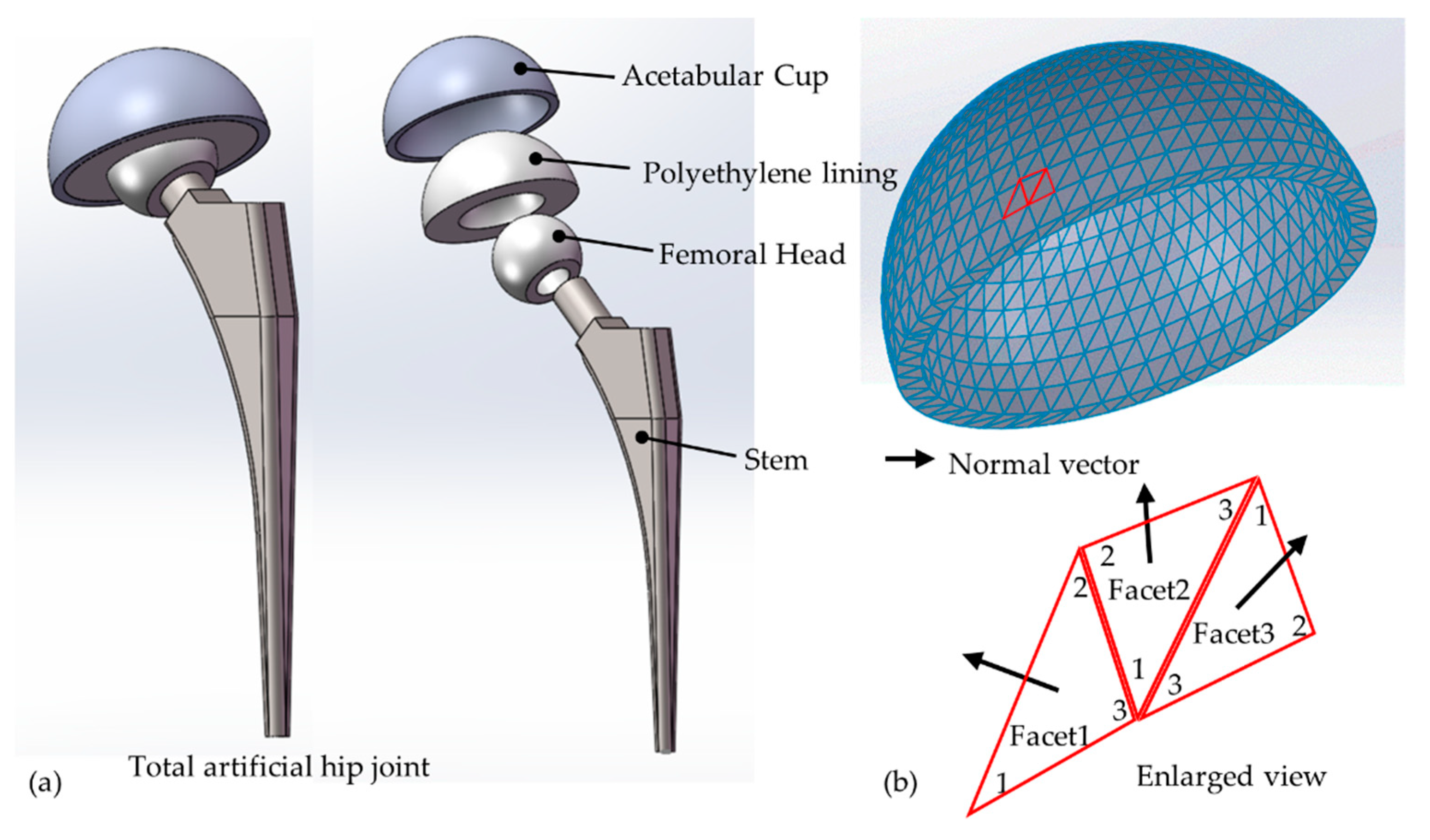


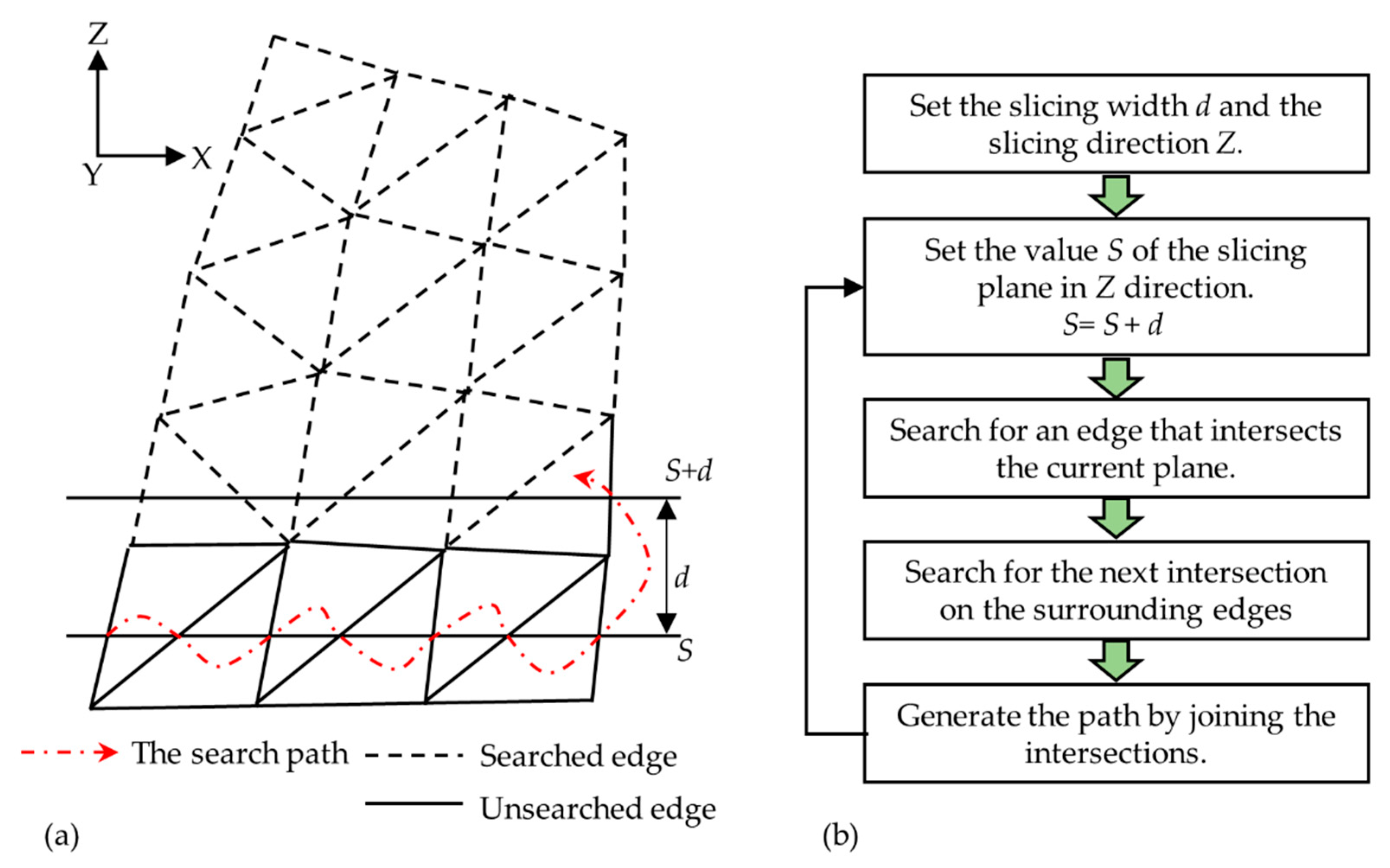
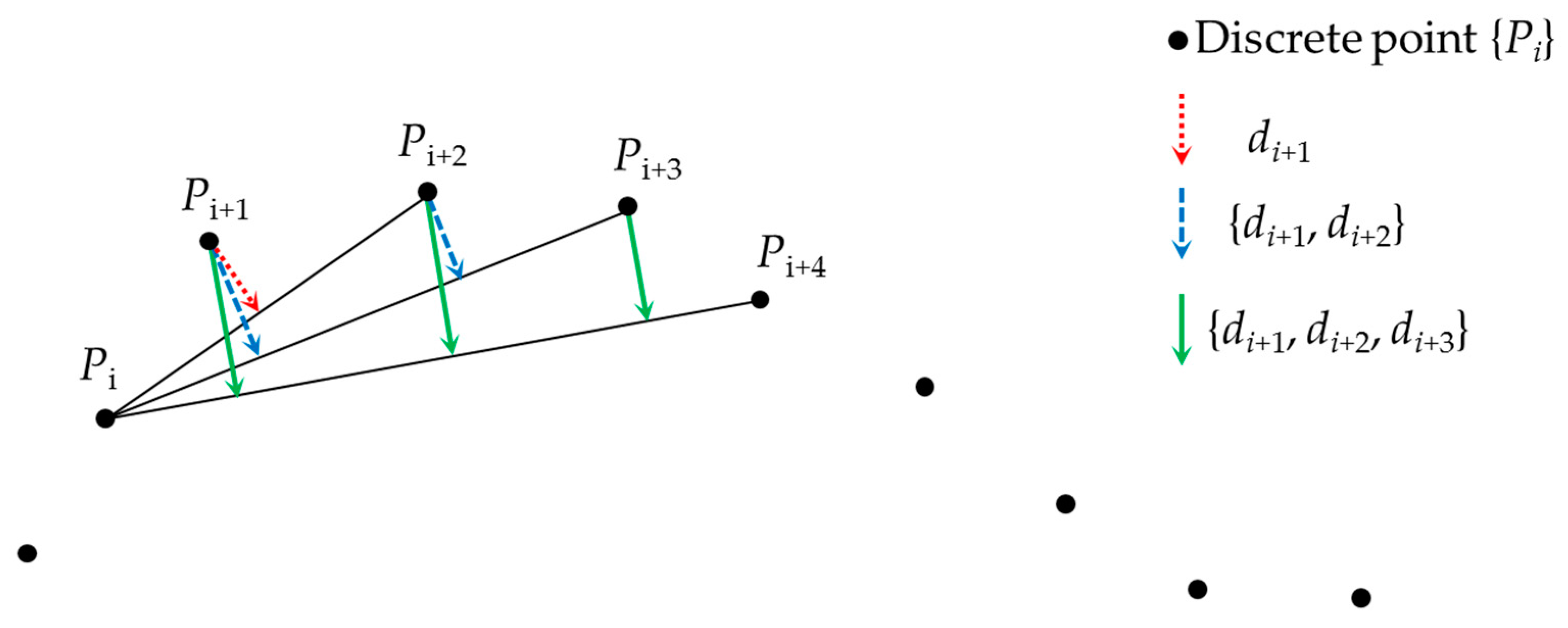
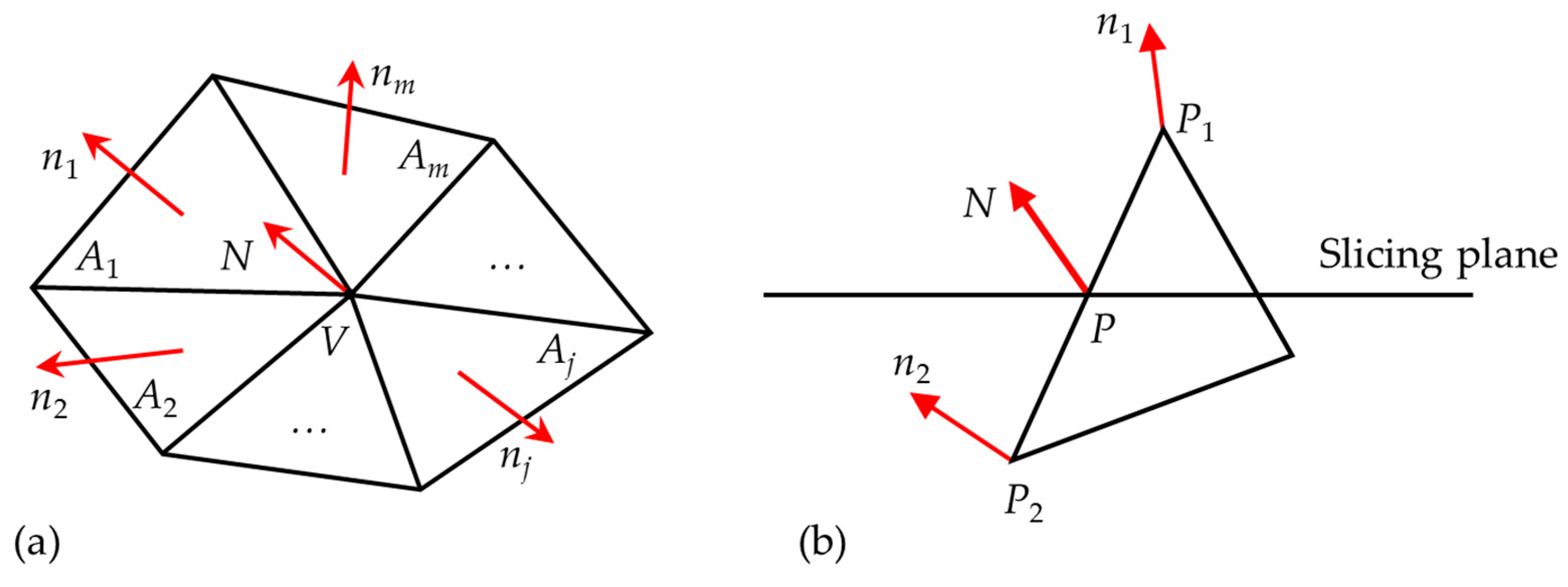
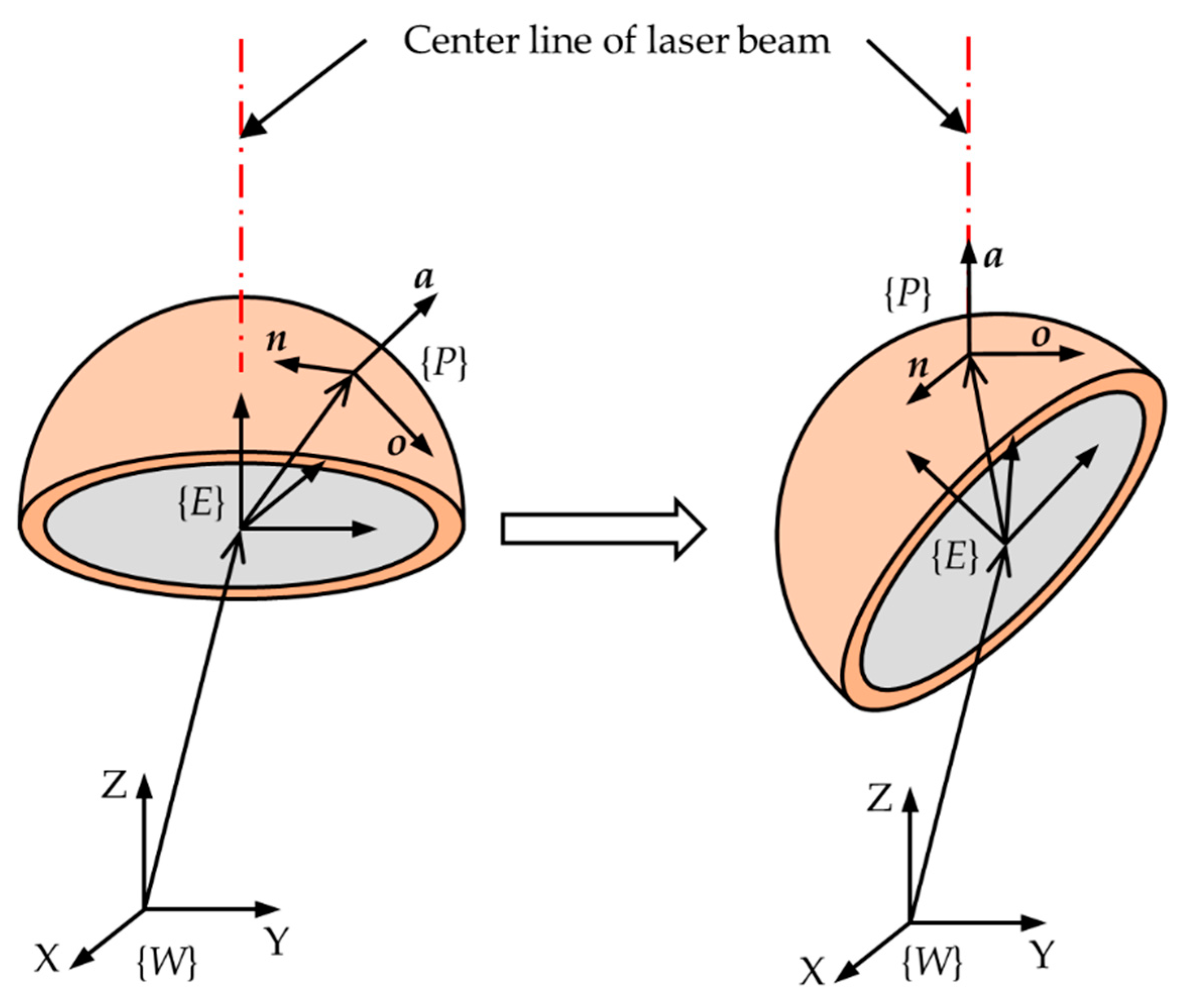



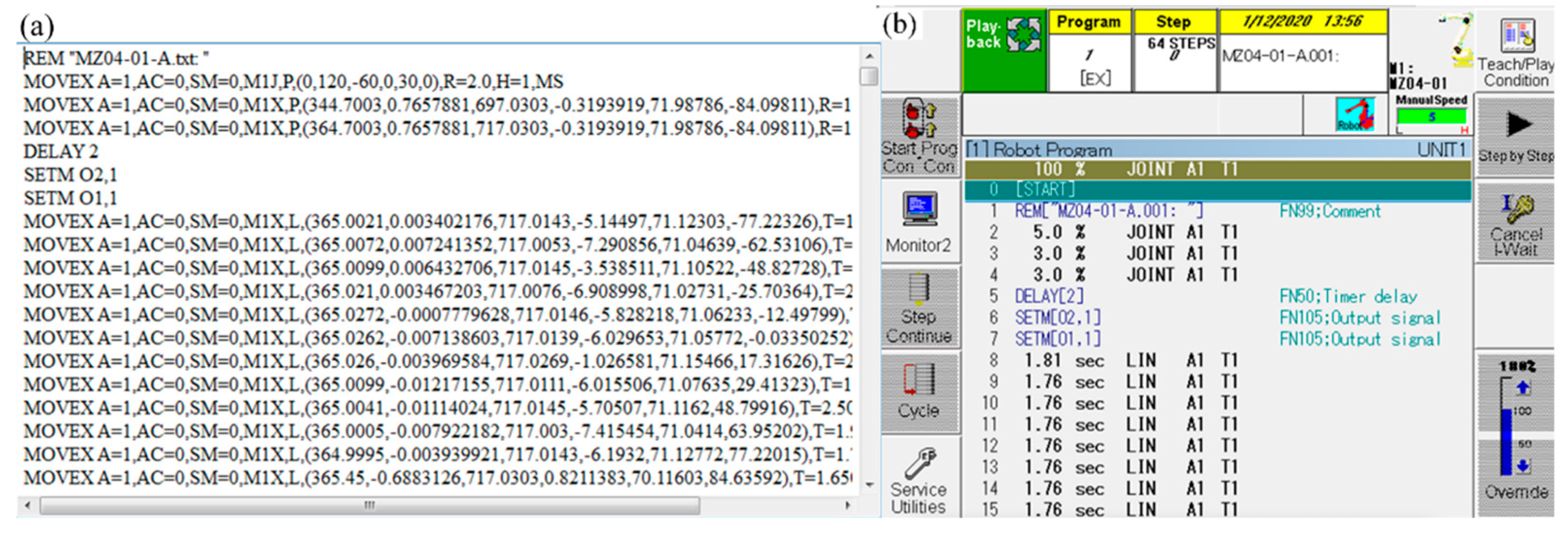


| Vertex | Edge | Facet | |
|---|---|---|---|
| Before topological reconstruction | 18 | 18 | 6 |
| After topological reconstruction | 7 | 12 | 6 |
| Edge Index | Relevant Vertex Index | Relevant Facet Index |
|---|---|---|
| E1 | V1, V2 | F1 |
| E2 | V1, V3 | F1, F2 |
| E3 | V2, V3 | F1, F6 |
| E4 | V1, V4 | F2 |
| E5 | V3, V4 | F2, F3 |
| E6 | V4, V6 | F3, F4 |
| E7 | V3, V6 | F3, F5 |
| E8 | V4, V5 | F4 |
| E9 | V5, V6 | F4 |
| E10 | V6, V7 | F5 |
| E11 | V3, V7 | F5, F6 |
| E12 | V2, V7 | F6 |
| Parameter | Value |
|---|---|
| Model size | Φ 46 mm |
| Slice direction | Z |
| Cladding spacing | 6 mm |
| Defocus distance | 15 mm |
| Allowable arch height error | 0.5 mm |
| STL File Size | Original Data | Data after Topological Reconstruction | ||||
| Facet | Edge | Vertex | Facet | Edge | Vertex | |
| 402KB | 3656 | 10,968 | 10,968 | 3656 | 5527 | 1872 |
| Number of Direct interpolation points | Number of simplified interpolation points | Compression ratio of interpolation points | Elapsed time | |||
| 850 | 74 | 8.7% | <30 sec | |||
© 2020 by the authors. Licensee MDPI, Basel, Switzerland. This article is an open access article distributed under the terms and conditions of the Creative Commons Attribution (CC BY) license (http://creativecommons.org/licenses/by/4.0/).
Share and Cite
Li, Y.; Chen, T.; Liu, D. Path Planning for Laser Cladding Robot on Artificial Joint Surface Based on Topology Reconstruction. Algorithms 2020, 13, 93. https://doi.org/10.3390/a13040093
Li Y, Chen T, Liu D. Path Planning for Laser Cladding Robot on Artificial Joint Surface Based on Topology Reconstruction. Algorithms. 2020; 13(4):93. https://doi.org/10.3390/a13040093
Chicago/Turabian StyleLi, Yuanjin, Tao Chen, and Defu Liu. 2020. "Path Planning for Laser Cladding Robot on Artificial Joint Surface Based on Topology Reconstruction" Algorithms 13, no. 4: 93. https://doi.org/10.3390/a13040093
APA StyleLi, Y., Chen, T., & Liu, D. (2020). Path Planning for Laser Cladding Robot on Artificial Joint Surface Based on Topology Reconstruction. Algorithms, 13(4), 93. https://doi.org/10.3390/a13040093





